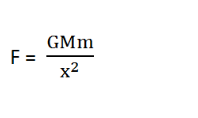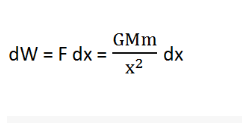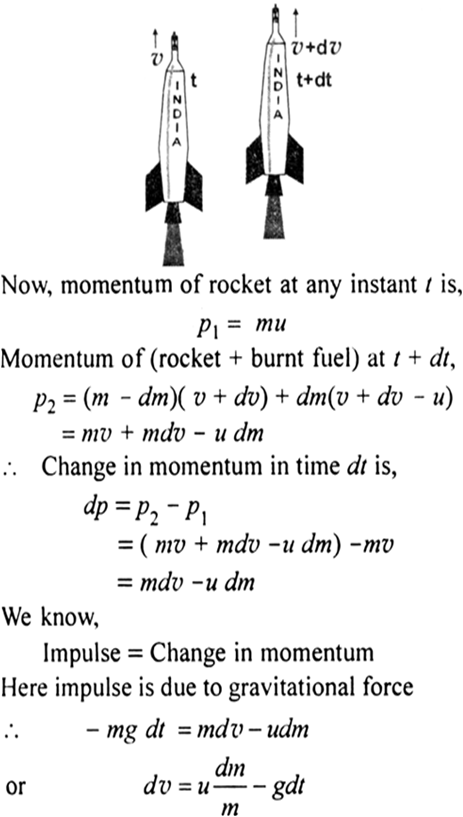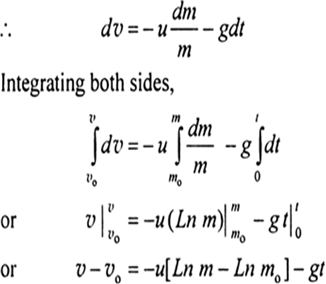Ask questions which are clear, concise and easy to understand.
Ask QuestionPosted by Bhima Devi Limbu 5 years ago
- 1 answers
Posted by Bhima Devi Limbu 5 years ago
- 1 answers
Yogita Ingle 5 years ago
According to Stokes law, if a spherical body falls into a viscous liquid then the force acting at the interface is proportional to – Radius of the spherical body, velocity of the sphere, and viscosity of this given fluid.
Posted by Mohit Pahal 5 years ago
- 2 answers
Gaurav Seth 5 years ago
If a body is taken from the surface of the earth to a point at a height ‘h’ above the surface of the earth, then ri = R and rf = R + h then,
ΔU = GMm [1/R – 1/(R+h)]
ΔU = GMmh/R(R + h)
When, h<<R, then, R + h = R and g = GM/R2.
On substituting this in the above equation we get,
Gravitational Potential Energy ΔU = mgh
Yogita Ingle 5 years ago
When a body of mass (m) is moved from infinity to a point inside the gravitational influence of a source mass (M) without accelerating it, the amount of work done in displacing it into the source field is stored in the form of potential energy this is known as gravitational potential energy. It is represented with the symbol Ug.
The equation for gravitational potential energy is:
⇒ GPE = m⋅g⋅h
Where,
- m is the mass in kilograms,
- g is the acceleration due to gravity (9.8 on Earth)
- h is the height above the ground in meters
Posted by Karan Jangir 5 years ago
- 4 answers
Gagandeep Kaur 4 years, 11 months ago
Raghav Dhir 5 years ago
Ranger King 5 years ago
Yogita Ingle 5 years ago
Newton’s Law of Universal Gravitation states that every particle attracts every other particle in the universe with a force that is directly proportional to the product of the masses and inversely proportional to the square of the distance between them.
Posted by Ranjan Borah 5 years ago
- 1 answers
Yogita Ingle 5 years ago
The dimensional formula of Velocity is given by,
M0 L1 T-1
Where,
- M = Mass
- L = Length
- T = Time
Posted by Gautam Chouhan 5 years ago
- 1 answers
Gaurav Seth 5 years ago
Potential energy is defined as the energy stored in an object. Potential energy can be divided into many types; Gravitational potential energy, Elastic Potential energy, Electric Potential Energy etc. Here the gravitational potential energy is defined as the energy possessed by an object by virtue of its position relative to others. Elastic potential energy is defined as the energy possessed by virtue of stresses within its body and an electric potential is defined as the energy possessed by an object by virtue of the total charge stored within.
Potential Energy Formula
The formula for gravitational potential energy is given below.
| PE = mgh |
Where,
- PE is the potential energy of the object in Joules, J
- m is the mass of the object in kg
- g is the acceleration due to gravity in ms-2
- h is the height of the object with respect to the reference point in m.
Posted by Gautam Chouhan 5 years ago
- 2 answers
Gagandeep Kaur 4 years, 11 months ago
Gaurav Seth 5 years ago
A body can have a constant speed but a changing velocity because the direction can change while the speed is constant. ... However, a body can not have a constant velocity with a changing speed.
For example :
A car can not be slowing down yet still be going the same speed and direction.
Posted by Kashish Sachdeva 5 years ago
- 1 answers
Yogita Ingle 5 years ago
Young’s modulus (Y) can be written as
Y = FL / (Ae)
Rearrange the above equation
F = YAe / L
= YAL / L ………[∵ Elongation (e) = L]
= YA
= 2 × 1011 N / m² × [1 cm² × 10^-4 m²/cm²]
= 2 × 107 N
Force required is 2 × 107 N
Posted by Riya Riya 5 years ago
- 4 answers
Gaurav Seth 5 years ago
The p-block is the region of the periodic table that includes columns 3A to column 8A and does not include helium. There are 35 p-block elements, all of which are in p orbital with valence electrons. The p-block elements are a group of very diverse elements with a wide range of properties.
</section> <section itemprop="mainEntity" itemscope="" itemtype="https://schema.org/Question">The elements s-block and p-block are so-called because their valence electrons are either in an orbital s or p. These are often called Standard Components, in order to differentiate them from the sequence of
</section>Ranger King 5 years ago
Posted by ?Ritesh Gupta☺️ 5 years ago
- 2 answers
Ranger King 5 years ago
Posted by Aadya Singh 5 years ago
- 2 answers
Posted by Divya Pareya 5 years ago
- 1 answers
Gaurav Seth 5 years ago
Given,
or
escape speed is given as
v = (2GM / R)1/2
here
M is the mass of the planet
R is the radius of the planet
now, for Mars
vm = (2GMm / Rm)1/2
for earth
ve = (2GMe / Re)1/2 = 11.2 km/s
we are given
Mm = Me/9
and Rm = Re/2
thus, we have
vm = (2GMm / Rm)1/2 = (2G(Me /9) / (Re/2))1/2
or
vm = (2/9)1/2 . (2GMe / Re)1/2 = (2/9)1/2.ve
thus,
vm = 0.4714 x ve
or
vm = 0.4714 x 11.2
so, the escape speed of Mars will be
vm = 5.27 km/s
= 7.47 km/sec.
Posted by Aqua Gaming 5 years ago
- 1 answers
Gaurav Seth 5 years ago
The impulse experienced by the object equals the change in momentum of the object. In equation form, F • t = m • Δ v. In a collision, objects experience an impulse; the impulse causes and is equal to the change in momentum.
Posted by Devansh Shukla 5 years ago
- 0 answers
Posted by Shoaib Abid Khuleibam 5 years ago
- 2 answers
Ranger King 5 years ago
Posted by Akash Kumar 5 years ago
- 2 answers
Yogita Ingle 5 years ago
here exists a third category: force of constraint.
Forces of constraint aren't either conservative or non-conservative forces, because they never do work (positive or negative) of their own (only transmit work from other forces). I suppose if you had to classify a force of constraint, it would be conservative, since it doesn't cause any irreversible processes.
Forces of constraint either always act perpendicular to motion, or prevent motion in their direction.
Conservative forces will have an associated potential energy, such that when such a force does positive work on a body, the body changes from having potential energy to kinetic energy. The opposite occurs when a conservative force slows down said object.
Non-conservative forces are forces for which we aren't really interested in tracking associated energy, and even if we were interested it tracking said energy, processes involving non-conservative forces are irreversible, and it is useless to define an associated potential energy.
Posted by Harshali Gavit 5 years ago
- 3 answers
Karan Sharma 5 years ago
Yogita Ingle 5 years ago
Following are the four fundamental forces in nature:
- Gravitational force: Gravitational force is one of the four fundamental forces of nature. It is the weakest of the four. It is also the attractive force which arises from the gravitational interaction.
Example:
(i) The revolving of the moon around the earth is due to gravitational attraction between them.
(ii) The formation of tides in the ocean is due to the gravitational force acting between the earth and the moon. - Electromagnetic force:: It is the force between charged particles. Charges at rest have electric attraction (between unlike charges) and repulsion (between like charges). Charges in motion produce magnetic force. Together they are called Electromagnetic Force.
- Strong nuclear force:
- Strong Nuclear Force: It is the attractive force between protons and neutrons in a nucleus.It is charge-independent and acts equally between a proton and a proton, a neutron and a neutron, and a proton and a neutron. Recent discoveries show that protons and neutrons are built of elementary particles, quarks.
- Weak nuclear force: This force appears only in certain nuclear processes such as the β-decay of a nucleus. In β-decay, the nucleus emits an electron and an uncharged particle called neutrino.This particle was first predicted by Wolfgang Pauli in 1931.
Posted by Hadiya Mirza 5 years ago
- 1 answers
First Name 5 years ago
Posted by Karthik A 5 years ago
- 1 answers
Rashmi Ahuja 5 years ago
Posted by Dipesh Yadav 5 years ago
- 1 answers
Gaurav Seth 5 years ago
Assume a perfect sphere-shaped planet of radius R and mass M. Now, if a body of mass m is projected from a point A on the surface of the planet. An image is given below for better representation:
sIn the diagram, a line from the center of the planet i.e. O is drawn till A (OA) and extended further away from the surface. In that extended line, two more points are taken as P and Q at a distance of x and dx respectively from the center O.
Now, let the minimum velocity required from the body to escape the planet b
ve
Thus, Kinetic Energy will be

At point P, the body will be at a distance x from the planet’s center and the force of gravity between the object and the planet will be:

To take the body from P to Q i.e. against the gravitational attraction, the work done will be->

Now, the work done against the gravitational attraction to take the body from the planet’s surface to infinity can be easily calculated by integrating the equation for work done within the limits x=R to x=∞.
Thus,

By integrating it further, the following is obtained:

Thus, the work done will be:

Now, to escape from the surface of the planet, the kinetic energy of the body has to be equal to the work done against the gravity going from the surface to infinity. So,
K.E. = W
Putting the value for K.E. and Work, the following equation is obtained:

From this equation, the escape velocity can be easily formulated which is:

Putting the value of g = GM, the value of escape velocity becomes:

From this equation, it can be said that the escape velocity depends on the radius of the planet and the mass of the planet only and not on the mass of the body.
Escape Velocity of Earth:
From the above equation, the escape velocity for any planet can be easily calculated if the mass and radius of that planet are given. For earth, the values of g and R are:
g = 9.8 m
R = 63,781,00 m
So, the escape velocity will be:
ve=2×9.8×63,781,00−−−−−−−−−−−−−−−−√
Escape Velocity of Earth= 11.2 km/s.
Posted by Sriya Verma 5 years ago
- 3 answers
Abirami Kamalbabu 5 years ago
Posted by Karan Rana 5 years ago
- 1 answers
Posted by Tabbu Fafamariya 5 years ago
- 0 answers
Posted by Yash Kamble 5 years ago
- 1 answers
Gaurav Seth 5 years ago
Let us consider, rocket of mass m0 take off with velocity v0 from ground. Let the fuel burnt at the rate of dm/dt and burnt gases eject with velocity u w.r.t. rocket.
Let at any instant t, v be the velocity of rocket and m be the mass of rocket. Therefore velocity of burnt gas ejected w.r.t. ground is (v – u). As the fuel burns at the rate of dm/dt, therefore in time dt, dm mass of the fuel will burn and velocity of rocket increases by dv.

Here m is the mass of rocket and dm is the mass of gas ejected. As the fuel burns the mass of rocket decreases. Therefore, to calculate the velocity of rocket at any instant in terms of mass of rocket, dm must be replaced by ‘dm’.



myCBSEguide
Trusted by 1 Crore+ Students

Test Generator
Create papers online. It's FREE.

CUET Mock Tests
75,000+ questions to practice only on myCBSEguide app
 myCBSEguide
myCBSEguide
Gaurav Seth 5 years ago
The viscous force acting on a sphere is directly proportional to the following parameters:
Mathematically, this is represented as
F∝ηarbvc
Now let us evaluate the values of a, b and c.
Substituting the proportionality sign with an equality sign, we get
F=kηarbvc (1)
Here, k is the constant of proportionality which is a numerical value and has no dimensions.
Writing the dimensions of parameters on either side of equation (1), we get
[MLT–2] = [ML–1T–1]a [L]b [LT-1]c
Simplifying the above equation, we get
[MLT–2] = Ma ⋅ L–a+b+c ⋅ T–a–c (2)
According to <a href="https://byjus.com/physics/mechanics/">classical mechanics</a>, mass, length and time are independent entities.
Equating the superscripts of mass, length and time respectively from equation (2), we get
a = 1 (3)
–a + b + c = 1 (4)
–a –c = 2 or a + c = 2 (5)
Substituting (3) in (5), we get
1 + c = 2
c = 1 (6)
Substituting the value of (3) & (6) in (4), we get
–1 + b + 1 = 1
b = 1 (7)
Substituting the value of (3), (6) and (7) in (1), we get
F=kηrv
The value of k for a spherical body was experimentally obtained as 6π
Therefore, the viscous force on a spherical body falling through a liquid is given by the equation
F=6πηrv
1Thank You